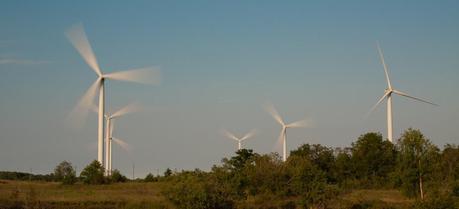 Pakri wind farm in Estonia. (Credit: Flickr @ Kain Kalju https://www.flickr.com/photos/kainkalju/)
Pakri wind farm in Estonia. (Credit: Flickr @ Kain Kalju https://www.flickr.com/photos/kainkalju/)Scientists at the Carnegie Mellon University have quantified what the price of energy storage needs to be to justify the use of energy storage devices at remote wind farms.
The best wind resources are often located in areas that are far away from where people live and use electricity. However, the transmission costs, which are the overall cost of building and maintaining transmission lines to these resources, are expensive.
SEE ALSO: Canada Installs Record Wind Power Capacity in 2013
Wind farms could elect to make a large investment in infrastructure, but, because wind does not blow constantly, even the best wind resources in the Midwest are not able to operate to full capacity all the time; many only produce about half the energy they could per year, on average. Farms are forced to make a choice: do they invest in infrastructure that allows them to transmit all of the energy they could produce given ideal conditions, or do they opt for cheaper lines and risk potentially losing some of their product on high yield days?
“By adding energy storage such as batteries or CAES, the farm could store electricity when transmission is constrained, and sell it later when transmission frees up,” said Julian Lamy, a Ph.D. candidate in the Engineering and Public Policy (EPP) Department and co-author of the study with EPP Associate Professor Inês Azevedo and EPP Assistant Professor Paulina Jaramillo.
Azevedo, who also is the co-director for Carnegie Mellon’s Climate and Energy Decision Making Center, notes that while the solution sounds easy, the costs associated with storage are so high that it often makes more sense to invest in wind resources that are closer to communities until the cost of storing energy at remote wind farms can be reduced.
The costs for energy storage would have to be below $100/kW·h for this strategy to make sense, which is about three times lower than optimistic cost projections for batteries and other storage technologies.
However, the group notes that storage devices can serve other functions that could help the grid. When the wind is not blowing, electricity must come from a different source, such as coal power plants, so that consumers do not experience disruptions in their service. A second option is to use batteries or other devices that could store energy when the wind farm output is high, and use it later when it is not.
Lamy, J., Azevedo, I., & Jaramillo, P. (2014). The role of energy storage in accessing remote wind resources in the Midwest Energy Policy, 68, 123-131 DOI: 10.1016/j.enpol.2014.01.008
